The thirteenth webinar of a series "Grounding and lightning protection: issues and problems arising during design"
Webinar text. Page 2
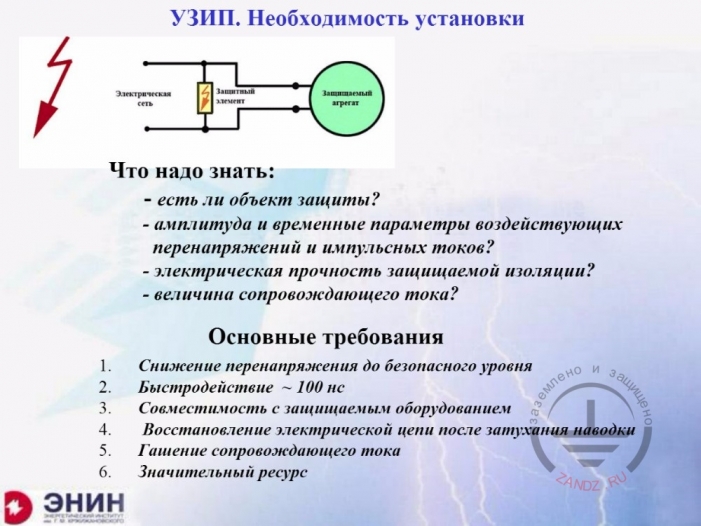
Surge protection device. The need for installation
УЗИП. Необходимость установки
Электрическая сеть
Защитный элемент
Защищаемый агрегат
Что надо знать:
- есть ли объект защиты?
- амплитуда и временные параметры воздействующих перенапряжений импульсных токов
- электрическая прочность защищаемой изоляции
- величина сопровождающего тока
Основные требования
1. Снижение перенапряжения до безопасного уровня
2. Быстродействие ∼100 нс
3. Совместимость с защищаемым оборудованием
4. Восстановление электрической цепи после затухания наводки
5. Гашение сопровождающего тока
6. Значительный ресурс
Заземлено и защищено
ЭНИН
SPD. The need for installation
Electrical network
Protective element
Protected plant
Must know:
- is there an object to be protected?
- amplitude and time parameters of affecting overvoltages of impulse currents
- electrical strength of protected insulation
- value of following current
Main requirements
1. Reduction of overvoltage down to safe value
2. Quick action ∼100 ns
3. Compatibility with protected equipment
4. Restoration of electrical circuit after attenuation of pickup effect
5. Suppression of following current
6. High durability
Grounded and Protected
ENIN
- What you need to know select SPD? First of all, you have to know if there is an object for protection. The question is not idle. The second, with regard to the object of protection, you shall know what overvoltage this device is able to resist. Relevant data on the device insulation impulse strength shall be presented by the manufacturing plant. It is more likely, that the manufacturing plant is not able to observe these requirements, then you shall perform tests in order to determine the overvoltage which the insulation of the device in question will withstand. Further you shall understand, which overvoltage occurs in relevant network, which the level hereof and which are follow currents conducted through SPDs installed by you in case of such overvoltage? And finally, you shall know, if the follow current will be the circuit from the network of 220-380V in case of SPD actuation by making short circuit in the network? If so, then which is value of that current, SPD shall withstand and interrupt it. Once you know all these requirements, you may use catalogues of any companies upon your discretion and select SPDs based on relevant values.
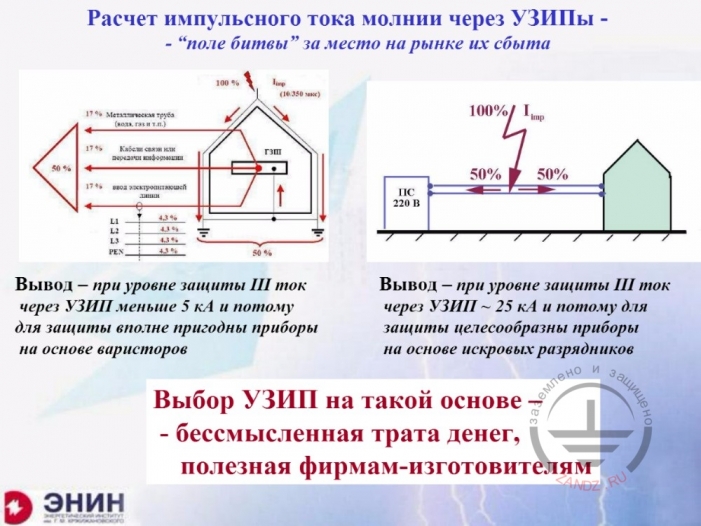
Calculation of lightning pulse current going through SPDs
Расчет импульсного тока молнии через УЗИПы – поле битвы за место на рынке их сбыта
Металлическая труба (вода, газ и т.п.)
Кабели снятия или передачи информации
Ввод электропитающей линии
ГЭЩ
ПС220В
Вывод – при уровне защиты III ток через УЗИП меньше 5 кА и потому для защиты вполне пригодны приборы на основе варисторов
Вывод – при уровне защиты III ток через УЗИП меньше ∼25 кА и потому для защиты целесообразны приборы на основе искровых разрядников
Выбор УЗИП на такой основе – бессмысленная трата денег, полезная фирмам-изготовителям
Заземлено и защищено
ЭНИН
Calculation of impulse current of lightning through SPDs as a battle field for SPDs sale market portion
Metal pipe (water, gas, etc.)
Data cables
Power supply line input terminal
MEB
220V SS
Conclusion – with protection level III the current though SPDs is lower than 5 kA, thus varistor-based devices could be applicable for protection
Conclusion – with protection level III the current through SPDs is lower than ∼25 kA, therefore spark arrester-based devices are appropriate
Selection of SPDs according to conclusions given above is inefficient waste of money for the benefit of manufacturers
Grounded and Protected
ENIN
- But the problem is that no standard which anyhow is related to SPDs contains methodologies for calculation of parameters I’m talking about. At least two things should be calculated. First, one should calculate the overvoltage level, second, one should calculate which pulse currents will go to SPD if installed. Here, I found two diagrams in Internet, which allegedly show calculation of a portion of the lightning current going into SPD. Look at the left diagram. Lightning strike into a building or to a lightning rod installed hereon. Which calculation is offered to you? It is very simple. Half of the lightning current will affect the grounding electrode of the facility itself. Why a half? Nobody knows that. Possibly, authors of this recommendation do not know as well. The second half will be divided in equal parts among all metal utilities of the building. What is meant by that? Water supply and heating pipelines, you know. Telephone line is meant and metal sewerage, if any. Now current is distributed uniformly between these three channels. It means, that 1/3 of a half will go to the electric network. Electrical network has four cables.
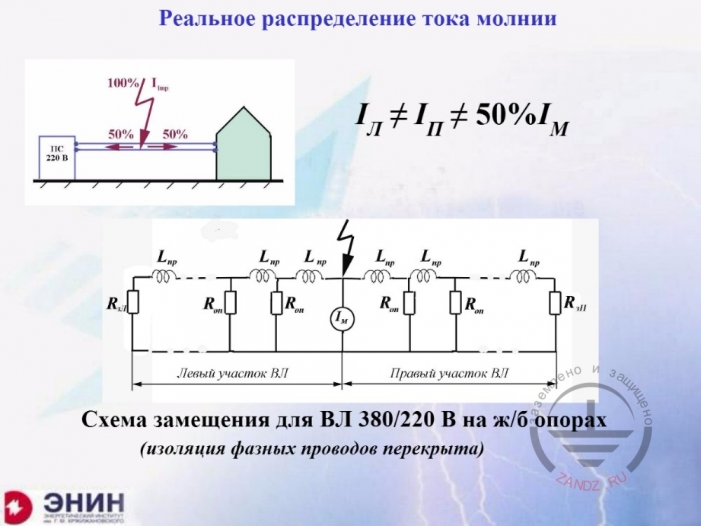
Real distribution of lightning current
Реальное распределение тока молнии
Левый участок ВЛ
Правый участок ВЛ
Схема замещения для ВЛ 380/220В на ж/б опорах (изоляция фазных проводов перекрыта)
Заземлено и защищено
ЭНИН
Real lightning current distribution
Left section of overhead line
Right section of overhead line
Equivalent circuit for 380/220V overhead line with reinforced concrete supports (insulation of phase wires is overflushed)
Grounded and Protected
ENIN
- There is nothing similar and the reason why is the following. The question is how will the current be distributed in reality. This will be distributed as follows. Cables have inductance and supports are fitted with grounding, if these are made of reinforced concrete. After all, the building is fitted with grounding, as well as the substation. As a result we have a kind of the following substitution diagram which is demonstrated here in the poster. The number of relevant components to the right and to the left corresponds to the number of supports on the right and on the left.
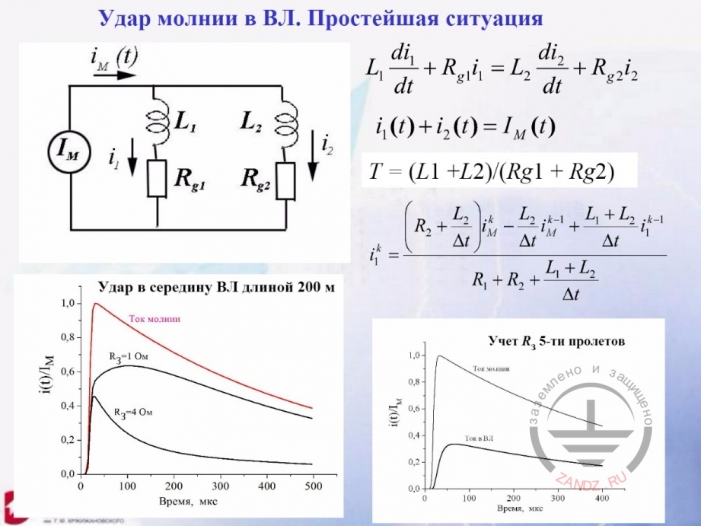
Lightning strike to the overhead line. It is a simple situation
Удар молнии в ВЛ. Простейшая ситуация
Удар в середину ВЛ длиной 200 м
Ток молнии
Ом
Учет R3 5-ти пролетов
Время, мкс
Заземлено и защищено
ЭНИН
Lightning strike into overhead line. Simple example
Strike into the middle point of 200 m overhead line
Lightning current
Ohm
Taking into account R3 of 5 spans
Time, μs
Grounded and Protected
ENIN
- Imagine, that for today we are able to calculate this diagram without any problems. Now imagine the result, if we take the simplest variant. This variant is the following. You have one span to the right and we will take the inductance hereof and resistance of the building grounding. And you have one span to the left and the substation grounding resistance. So, the result will be the following. At the first moment of time the lightning current will be distributed with a inverse proportionality to the inductance of right and left circuits. Once transient period is over, then the distribution will be inverse proportional to the inductance of right and left circuits. Depending on inductance and resistance values, currents could be distributed in most incredible ways. For instance, It could be the following. For the left equivalent circuit diagram with many utilities the result could be that up to 90% of current and even more will go to cabling. This needs to be taken into account. Otherwise could be when it is assumed that you have power transmission line with small amount of current going by that line to your building, whereas the most amount of current will go to the substation. Both are possible, you always shall calculate, and the calculation methodology is well developed. Here it is in posters. But equivalent circuits from substations, that is to say from companies, show nothing to be similar.
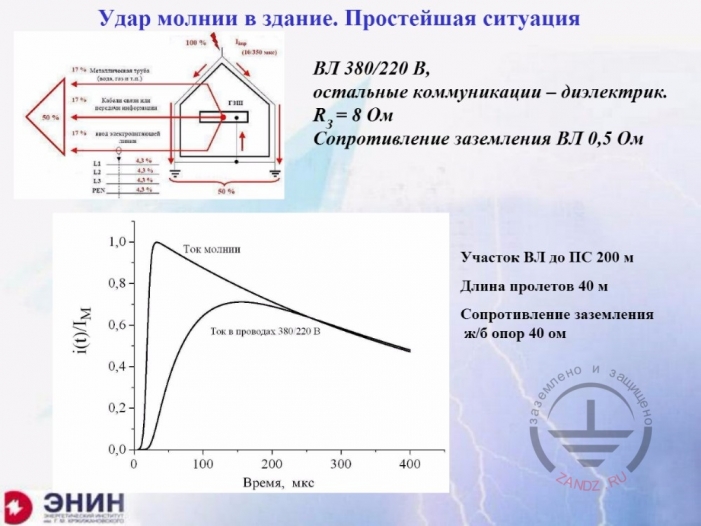
Lightning strike into the building. It is a simple situation
Удар молнии в здание. Простейшая ситуация
ВЛ 380/220 В,
остальные коммуникации – диэлектрик.
Сопротивление заземления ВЛ 0,5 Ом
Участок ВЛ до ПС 200 м
Длина пролетов 40 м
Сопротивление заземления ж/б опор 40 см
Ток в проводах 380/220 В
Металлическая труба (вода, газ и т.п.)
Кабели снятия или передачи информации
Ввод электропитающей линии
ГЭЩ
Ток молнии
Ом
Время, мкс
Заземлено и защищено
ЭНИН
Lightning strike into building. Simple example
380/220V overhead line.
Other utilities are made of dielectric material.
Overhead line grounding resistance is 0.5 Ohm
Overhead line section to SS of 200 m
Span length is 40 m
40 cm reinforced concrete support grounding resistance
Current in 380/220 V conductors
Metal pipe (water, gas, etc.)
Data cables
Power supply line input terminal
MEB
Lightning current
Ohm
Time, μs
Grounded and Protected
ENIN
- What to do now? The following thing needs to be done. Either you do calculation by yourself or wait until a new methodology will appear in Russia, that is to say new-but-well-known methodology, because these things we all know well. Methodology for calculation of current conducted by cables of power transmission lines. In any case, in no way one should rely upon diagrams presented by SPD manufacturers with no calculation performed. No doubts at all.
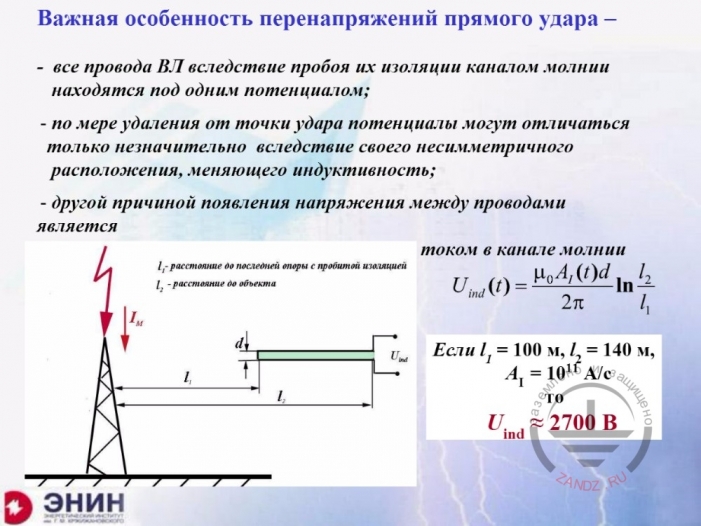
Important peculiarity of direct strike overvoltage
Важная особенность перенапряжений прямого удара -
- все провода ВЛ вследствие пробоя их изоляции каналом молнии находятся под одним потенциалом;
- по мере удаления от точки удара потенциалы могут отличаться только незначительно вследствие своего несимметричного расположения, меняющего индуктивность;
- другой причиной появления напряжения между проводами является ток в канале молнии
Расстояние до последней опоры с пробитой изоляцией
Расстояние до объекта
Если
м
В
Заземлено и защищено
ЭНИН
Main peculiarity of direct strike overvoltage -
- all overhead line wires are under the same potential due to breakdown of insulation hereof;
- potential may differ insignificantly with the distance from the strike point because of non-symmetrical position changing inductivity;
- other cause of voltage between channels is lightning channel current
Distance to last support with broken down insulation
Distance to the facility
If
M
V
Grounded and Protected
ENIN
—Here is the following aspect. Very important thing to be learnt and understood when you select SPD arrangement diagram. If you have power transmission line which was suffered from lightning strike, then, of course, flashover will be on insulation of all cables on the support or insulation of aerial bundled current conductor (ABC) suspended on the support. And all cables will be under the same potential, because of general short-circuit caused by the lightning. There will be no overvoltages between phase cables next by the line. All overvoltages will be under the same potential relative to the earth and neutral will be between them. Will there be any overvoltage between phase cables? Actually, yes.
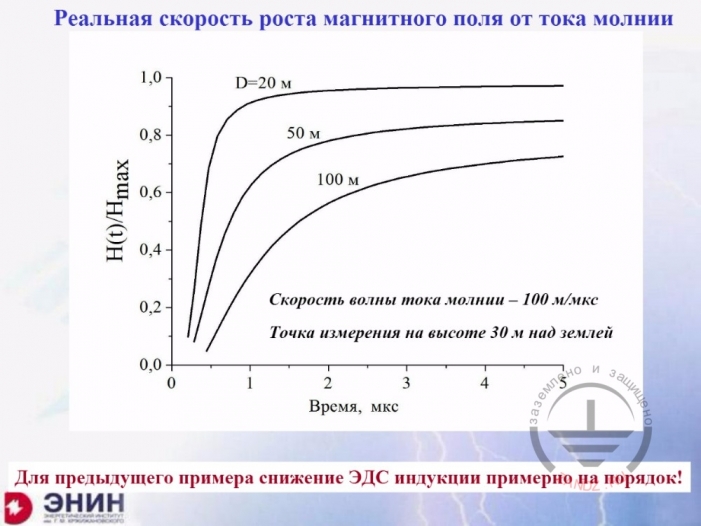
Real increase rate of magnet field due to lightning current
Реальная скорость роста магнитного поля от тока молнии
Скорость волны тока молнии
100 м/мкс
Точка измерения на высоте 30 м над землей
Время, мкс
Для предыдущего примера снижение ЭДС индукции примерно на порядок!
Заземлено и защищено
ЭНИН
Real rate of magnet field growth caused by lightning current
Lightning current wave speed
100 m/μs
Measurement point at the height of 30 m above the ground
Time, μs
EMF of induction is decreased about an order in comparison with previous example!
Grounded and Protected
ENIN
- A company guides you to calculation. Open the IEC Lightning Protection Standard or guidelines SO-153 for lightning protection of buildings and facilities of industrial utilities which say that the highest steepness of lightning current reaches the first protection level up to 2x1,011 A/s, and for the third protection level, this will be not 2x1,011 A/s but 1x1011 A/s. And if you insert such values into overvoltage calculation, you will derive enormous results making you run to a shop, of course, for buying SPD. This is a reason for you to buy. What will occur for real? Imagine the following situation. There is a lightning rod. It was struck by lightning. And there is an electrical circuit at a distance, let it be 20, 30, 50 and even 100 metres, for which you will calculate induced overvoltage. The standard says true what concerns the steepness of current change, however the issue is another. How lightning current is generated? And how the lightning current is distributed by the lightning rod and by the lightning channel? It appears that the lightning current fills the channel not instantly. Wave runs with certain speed. It is the speed of light for metal conductor, but in the lightning channel itself it is three or even five times lower. Because of certain speed of conductor filling with current, the overvoltage appears to be considerably lower than values you derived. Magnetic field strength wave is smoothed. Smoothing is higher as longer the distance from circuit in which you determine induced overvoltage to the lightning rod and lightning channel.
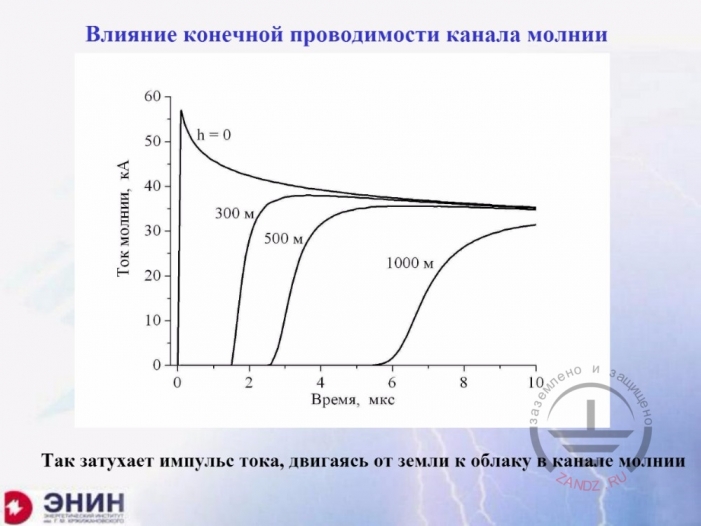
Influence of finite conductivity of lightning channel
Влияние конечной проводимости канала молнии
Ток молнии, кА
м
Время, мкс
Так затухает импульс тока, двигаясь от земли к облаку в канале молнии
Заземлено и защищено
ЭНИН
Influence of finite conductivity of the lightning channel
Lightning current, kA
m
Time, μs
Current impulse is attenuating in this way running from the ground to cloud by the lightning channel
Grounded and Protected
ENIN
- And there is one more thing to conclude. When the wave runs, the current wave runs from the earth to the cloud by the lightning channel, which wave in the lightning channel attenuates because of finite nature of the lightning plasma channel conductivity, though it is high enough, but moderate. And the current wave is smoothed; amplitude and steepness hereof is decreased. As a result, existing induced overvoltages appear to be more lower. This should be taken into account, unfortunately, no one does in this way.
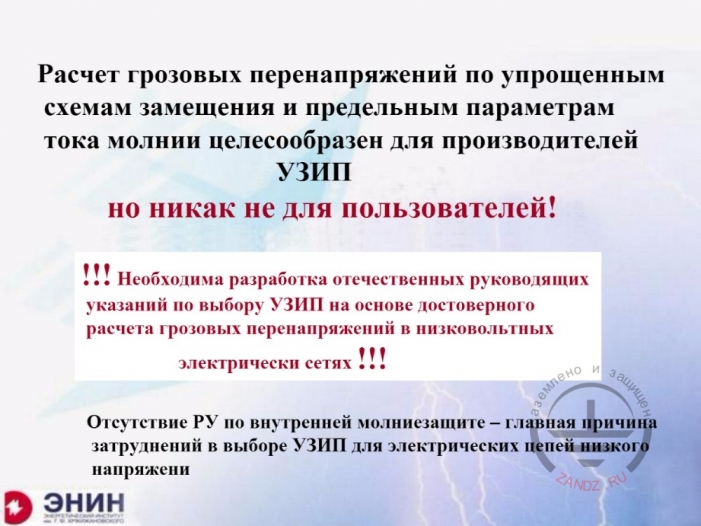
Calculation of overvoltages by using simplified equivalent circuits
Расчет грозовых перенапряжений по упрощенным схемам замещения и предельным параметрам тока молнии целесообразен для производителей УЗИП
Но никак не для пользователей!
Необходима разработка отечественных руководящих указаний по выбору УЗИП на основе достоверного расчета грозовых перенапряжений в низковольтных электрических сетях!!!
Отсутствие РУ по внутренней молниезащите – главная причина затруднений в выборе УЗИП для электрических цепей низкого напряжения
Заземлено и защищено
ЭНИН
Calculation of thunderstorm overvoltages based on simplified equivalent diagrams and limit parameters of lightning current is promoted by SPDs manufacturers
But not for the users’ benefit!
It is required to develop national regulatory guidelines on selection of SPDs on the basis of reliable calculation of thunderstorm overvoltages in low voltage electrical networks!!!
Absence of regulatory guidelines on internal lightning protection is main cause of problems in selection of SPDs for low-voltage electrical circuits
Grounded and Protected
ENIN
- This is why calculation of overvoltages, which can be done today by using simplified equivalent circuits, all and no exceptions is designed to select SPDs which a company issuing recommendations wants for sale. Therefore, now we may consider the situation to be as follows. Our Russian regulatory document for the lightning protection is not appropriate for calculation of overvoltage levels in low-voltage power networks. This issue will be raised soon, of course. I suppose it will be at the future conference devoted to lightning protection to be held in May, Saint Petersburg. ThermoStream organizes this workshop over again; this issue will be raised there, however nobody will give your certain recommendations yet as to calculation of overvoltages, unless you refer to the sources existing today by yourself. I can recommend one thing. Let me say "If you don’t toot your own horn, nobody else will". "Grounding and lightning protection at ZANDZ.com" Project which is the organizer of these workshops has published a book. And I'm the author hereof. The book is called "Practical Lightning Protection Issues". This book covers issues on which I tried to throw the light before you today, but now, let me proceed with answers to asked questions.
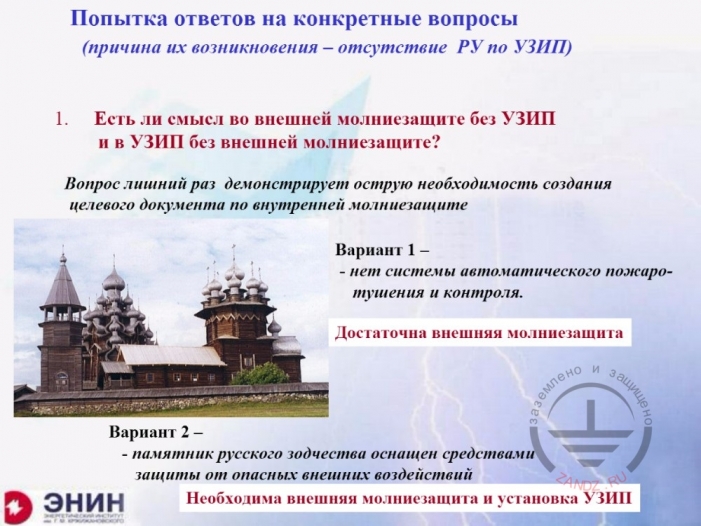
Effort of answering certain questions
Попытка ответов на конкретные вопросы
(причина их возникновения – отсутствие РУ на УЗИП)
1. Есть ли смысл во внешней молниезащите без УЗИП и в УЗИП без внешней молнизащиты?
Вопрос лишний раз демонстрирует острую необходимость создания целевого документа по внутренней молниезащите
Вариант1 – нет системы автоматического пожаротушения и контроля.
Достаточна внешняя молниезащита
Вариант 2 – памятник русского зодчества оснащен средствами защиты от опасных внешних воздействий
Необходима внешняя молниезащита и установка УЗИП
Заземлено и защищено
ЭНИН
Effort to answer certain questions
(reason for raising them is absence of regulatory guidelines for SPDs)
1. Is it appropriate to arrange external lightning protection without SPDs and vice versa?
This question once again demonstrates an acute need for making a target document for internal lightning protection.
Variant 1 – without automatic fire-fighting and security system.
Only external lightning protection is sufficient.
Variant 2 – Russian construction art monument is equipped with means of protection against dangerous external effects
Both external lightning protection and SPDs are required
Grounded and Protected
ENIN
- You know, a specific of these questions is the following. These were asked before the webinar. All these questions arising from the problem for people to find a regulatory document and once having no success, they ask questions for me to answer. The first question, is there a sense in external lightning protection without SPD and in SPD without external lightning protection? That is to say, is it sufficient to make only external or only internal lightning protection? I cannot tell you definitely just for the following reason. Imagine the following situation. This picture represents wooden church in Kizhi, the masterpiece of Russian art in building. The only what the church should be protected from is the direct strike voltage, unless it is fitted with any automatic fire-fighting means, fire alarms, perimeter security system or other electronics. In this case no SPDs are required or whatsoever, but only one properly made air terminal with proper transportation of lightning currents into the ground.
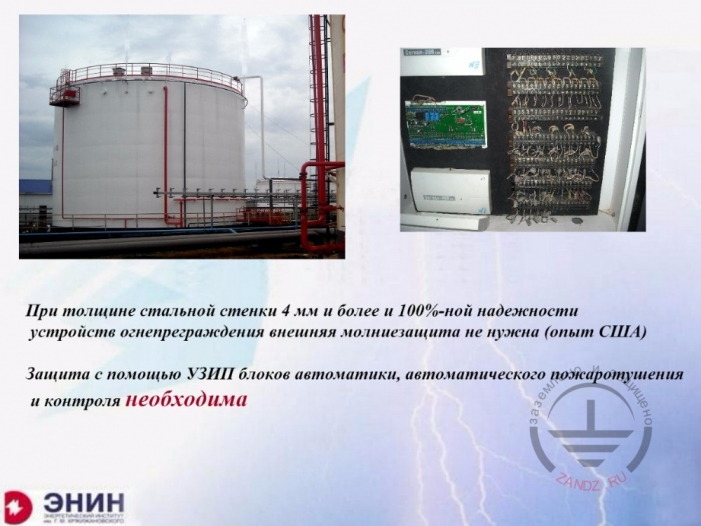
Oil products tank farm
При толщине стальной стенки 4 мм и более и 100% надежности устройств огнепргреждения внешняя молниезащита не нужна (опыт США)
Защита с помощью УЗИП блоков автоматики, автоматического пожаротушения и контроля необходима
Заземлено и защищено
ЭНИН
External lightning protection is not needed with the thickness of steel shell of 4 mm and more and 100% reliability of fire suppression devices (USA experience)
Protection of instrumentation and controls and fire-fighting automatics by using SPDs is necessary
Grounded and Protected
ENIN
- Now let's take a look at other situation. It is the following. There is the oil products tank farm. What should be done there? Today these farms are protected with air terminals on a mandatory basis. But this solution could be refused, if the tank steel shell thickness exceeds 4 mm, and fire suppression system at breather valves will not allow ingress inside the tank space. For instance, American experience has demonstrated that no air terminals are required, then it is not installed. And what to do in this case? For this case installation of SPDs only is sufficient. Where to install? For all I&Cs controlling the tank operation mode. First of all, for the fire-fighting system again. SPDs are required, but air terminals could appear useless. Is it clear? Therefore, the answer to the question is following: each case should be analyzed individually in terms of what needs to be protected and how, if any.
<< Previous Page
Slides from 1 to 11
Next Page >>
Slides from 23 to 32 + questions
Related Articles:
 Lightning Protection of Large Territories: Parks, Grounds, Plant Territories. Page 1
Lightning Protection of Large Territories: Parks, Grounds, Plant Territories. Page 1
 Lightning Protection of Large Territories: Parks, Grounds, Plant Territories. Page 2
Lightning Protection of Large Territories: Parks, Grounds, Plant Territories. Page 2
 Lightning Protection of Large Territories: Parks, Grounds, Plant Territories. Page 3
Lightning Protection of Large Territories: Parks, Grounds, Plant Territories. Page 3

